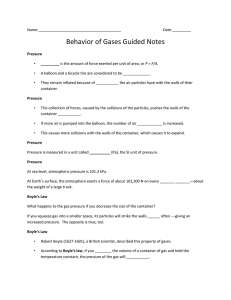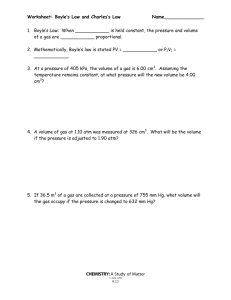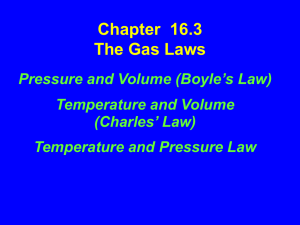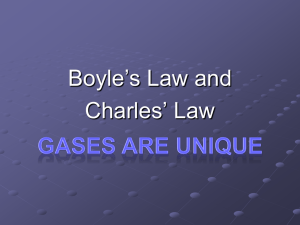Behavior of Gases - Effingham County Schools
advertisement
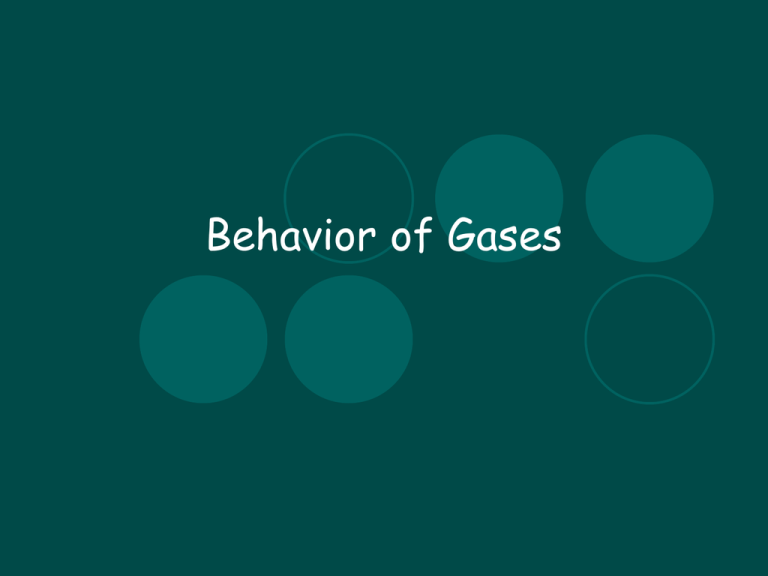
Behavior of Gases Behavior of Gases Pressure Boyle’s Law Temperature and Pressure Charles’ Law What is Pressure? Pressure is the amount of force exerted per unit of area, or P = F/A. In other words, pressure is a measure of the force felt by the walls of a container. A balloon and a bicycle tire are considered to be containers. They remain inflated because of collisions the air particles have with the walls of their container. Pressure This collection of forces, caused by the collisions of the particles, pushes the walls of the container outward. If more air is pumped into the balloon, the number of air particles is increased. This causes more collisions with the walls of the container, which causes it to expand. Units of Pressure The SI unit of pressure is called a pascal (Pa). Because pressure is the amount of force divided by area, one pascal of pressure is the amount of force divided by area or one Newton per square meter or 1 N/m2. What is Atmospheric Pressure? Atmospheric pressure is the pressure at any point in the Earth’s atmosphere. At Earth’s surface, the atmosphere exerts a force of about 101,300 N on every square meter—about the weight of an elephant. Atmospheric pressure decreases with altitude. Boyle’s Law Boyle’s law is one of the laws in physics that concern the behavior of gases. What happens to the gas pressure if you decrease the size of the container? If you squeeze gas into a smaller space, its particles will strike the walls more often giving an increased pressure. The opposite is true, too. Boyle’s Law (2) Robert Boyle (1627-1691), a British scientist, described this property of gases. According to Boyle’s law, if you decrease the volume of a container of gas and hold the temperature constant, the pressure of the gas will increase. An increase in the volume of the container causes the pressure to drop, if the temperature remains constant. Boyle’s Law (3) Boyle’s law states that as pressure is decreased the volume increases. The opposite also is true, as shown by the graph. As the pressure is increased, the volume will decrease. Below are the Results of an Experiment Pressure P Volume V P x V 1.1 40 44 1.7 26 2.2 20 2.6 17 Calculate P x V (pressure x volume) for each set of results. What do you notice? Boyle’s Law in Action When Boyle’s law is applied to a real life situation, we find that the pressure multiplied by the volume is always equal to a constant if the temperature is constant. You can use the equations P1V1 = constant = P2V2 to express this mathematically. • This shows us that the product of the initial pressure and volumedesignated with the subscript 1is equal to the product of the final pressure and volumedesignated with the subscript 2. Problem A deep sea diver is working at a depth where the pressure is 3.0 atmospheres. He is breathing out air bubbles. The volume of each air bubble is 2 cm3. At the surface the pressure is 1 atmosphere. What is the volume of each bubble when it reaches the surface? Solution We assume that the temperature is constant, so Boyle’s Law applies: Formula first: P1 x V1 = P2 x V2 Then numbers: = 3.0 atm x 2 cm3 = 1.0 atm x V2 Now rearrange the numbers so that you have V2 on one side, and the rest of the numbers on the other side of the ‘equals’ symbol. Solution (2) 3 3.0 atm x 2.0 cm V2 1.0 atm Therefore the volume of bubbles = 6.0 cm3. Note that P1 and P2 have the same units as do V1 and V2. Pressure and Temperature Relationship What happens if you heat an enclosed gas? The particles of gas will strike the walls of the canister more often. If the pressure becomes greater than the canister can hold, it will explode. At a constant volume, an increase in temperature results in an increase in pressure. Charles’ Law Jacques Charles (17461823) was a French scientist who studied gases. According to Charles’ law, the volume of a gas increases with increasing temperature, as long as pressure does not change. As shown in the graph, as with Boyle’s law, the reverse is also true. Charles’ Law (2) If we place a balloon in liquid nitrogen, it shrinks. So, gases shrink if cooled. Charles’ Law (3) A hot air balloon demonstrates that if we heat a gas, it expands. Both of these examples (shrinking balloon and hot air balloon) illustrate Charles’ law. Charles’ Law (4) Charles’ law can be explained using the kinetic theory of matter. As a gas is heated, its particles move faster and faster and its temperature increases. Because the gas particles move faster, they begin to strike the walls of their container more often and with more force. Using Charles’ Law The formula that relates the variables of temperature to volume shows a direct relationship, when temperature is given in Kelvin. When using Charles’ law, the pressure must be kept constant. V1 V2 T1 T2 Using Charles’ Law (2) • What would be the resulting volume of a 2.0-L balloon at 25.0C that was placed in a container of ice water at 3.0C? Solution As Charles’s law predicts, the volume decreased as the temperature of the trapped gas decreased.
